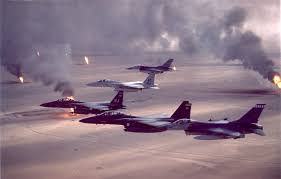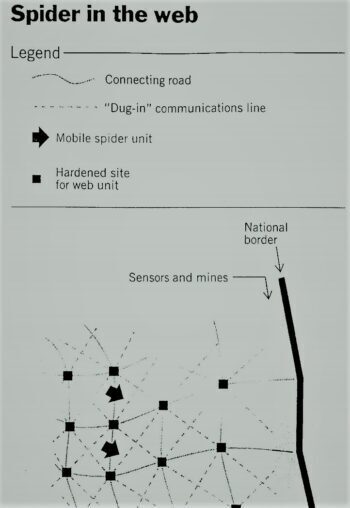by Alan Bloomgarden and Carl Conetta, Dec 1994.
➪ HTML
➪ PDF
This article first appeared in 1994 in a slightly edited form in Hawk Journal, the annual publication of the Royal Air Force Staff College.
The expectation of an airpower revolution began in earnest soon after victory in the first US-Iraq Gulf War, 1990-1991. Drawing extensively on official and outside expert assessment of airpower in “Operation Desert Storm,” this article critically reviews the evidence for an airpower revolution while summarizing a range of contemporary opinions on the issue.
Specifically, the article examines three claims advanced by airpower enthusiasts at the dawn of the post-Cold War period: that the Gulf War experience suggests greatly expanded options for limited-aims “raiding missions,” strategic bombing campaigns, and airpower dominance over the ground battle (using improved battlefield interdiction and close air support.)
Included are summaries of the extensive Gulf War Air Power Survey and other surveys of the war which provide an unsurpassed view of the war’s dynamics. It also examines the technologies, contemporary and in development, central to the putative airpower revolution.

by Carl Conetta and Lutz Unterseher. May 1994.
Newly published in ➪ PDF.
Originally, this primer was written and then published in spiral-bound book format for a series of seminars sponsored by the Study Group on Alternative Security Policy (SAS) and the Project on Defense Alternatives (PDA). These seminars were held in 1994 in several of the newly sovereign states of Europe: the Czech Republic, Hungary, and Belarus.
In 1994 no suitable seminar host was found in Ukraine. Although confidence-building defenses can not solve all of Ukraine’s strategic dilemmas during the present war with Russia, initial evidence strongly suggests that its military has made successful use of some of the principal aspects of a confidence-building defense.
The primer remains one of the most comprehensive presentations of the concepts of Confidence-Building Defense (C-BD), including details of their application to the structuring and operations of national armed forces. It totals 116 pages with 94 charts and tables.
Although some details of arms and tactics change over time, the fundamentals remain relevant to present-day international security, military planning, and the furthering of peaceful relations.
by Carl Conetta, Charles Knight, and Lutz Unterseher, PDA Research Monograph #1, February 1991.
➪ HTML ➪ PDF

Examines the character of force structure and military conflict in the Middle East and outlines a nonoffensive defense posture for nations in the region. It also draws the implications of such a posture for arms transfers and arms control policy. An appendix reviews the pertinent lessons of the 1990-91 Gulf War.
by Carl Conetta and Charles Knight, Institute for Defense and Disarmament Studies, May 1990.
The report takes a critical look at late-Cold War plans for defending Western Europe from the Warsaw Pact attack, finding these plans to be both unrealistic and destabilizing. It proceeds to clearly specify a robust alternative area-defense option and then considers standard objections to area-defense concepts.
“[L]ooking beyond the current bipolar orientation of central European armies, the adoption by nations in the region of spider-and-web defenses, reconfigured to provide all-around security, would help ensure the necessary military foundation for peaceful political, social, and economic development. “
by Carl Conetta and Charles Knight, Defense and Disarmament Alternatives, Institute for Defense & Disarmament Studies, 13 February 1990. ➪ PDF
For a summary of the contemporary European conventional arms control situation see Thomas K. Longstreth, “The Future of Conventional Arms Control in Europe,” FAS Public Interest Report Vol. 41 No. 2, February 1988 ➪ PDF
rapporteur, Carl Conetta. A workshop co-sponsored by the Institute for Defense and Disarmament Studies and the RAND Corporation featuring a presentation by Lutz Unterseher, a response by Barry Posen, and participant discussion, Washington, DC, 17 January 1989. ➪ PDF
In his presentation Unterseher warned that unless conventional arms reductions in Europe are combined with defensive reductions, they could actually undermine rather than improve stability by increasing both sides’ vulnerability to surprise attack. Posen agreed but judged that any significant shift toward a SAS-type alternative is not now feasible. Instead, a step-by-step process of bilateral reductions and restructuring might work.
by Carl Conetta, Conference Report, in Defense and Disarmament Alternatives, the newsletter of the Institute for Defense and Disarmament Studies (IDDS), January 1989.
 Report on the September 1988 conference, co-hosted by the Institute for World Economy and International Relations (IMEMO) and Institute for Defense and Disarmament Studies (IDDS), of Soviet and US arms control and military policy specialists. The report summarizes the exchange regarding problems and prospects for conventional force reductions in Europe.
Report on the September 1988 conference, co-hosted by the Institute for World Economy and International Relations (IMEMO) and Institute for Defense and Disarmament Studies (IDDS), of Soviet and US arms control and military policy specialists. The report summarizes the exchange regarding problems and prospects for conventional force reductions in Europe.
These meetings happened a little less than two months before President Gorbachev’s historic announcement at the UN in December of 1988 of substantial unilateral reductions and defensive restructuring of Soviet troops in eastern Europe – one of the most significant policy shifts in the process of ending the European Cold War. This international conference likely had more import than most.
by Charles Knight, 18 March 1988. PDF
In this previously unpublished paper from 1988, the author reviews various models for simulating war along the Central Front in Germany and their relevance for finding a stable conventional force balance in Europe (and elsewhere.) Force structures that tend to produce stable outcomes in battlefield simulations are likely to have more deterrent value in the real world.
“[C]omplex models [can] be very useful in distinguishing the conditions (i.e. force structures, tactics, and armaments) that produce chaotic, oscillating, or unstable outcomes from those that produce stable outcomes.
“The outcome of a conflict between balanced forces as currently structured is unknowable and unpredictable. This would seem to support the position that no stable conventional deterrent to war can be built, short of overwhelming superiority. If that was as far as our analysis went, we [might] end up giving support to flexible response doctrine with its fundamentally unstable nuclear deterrent component. Of course, the favored option is to model restructured conventional forces that can take us out of the chaotic conventional battlefield and give us stable outcomes.”
see full-text PDF
by John Grin and Lutz Unterseher, Bulletin of the Atomic Scientists, Volume 44, Issue 7, 1988.
